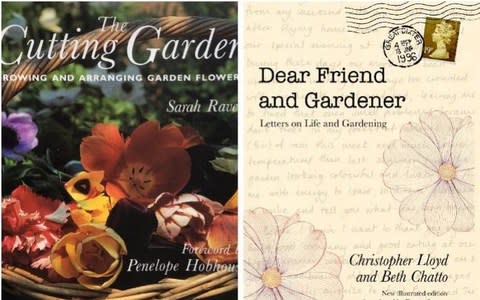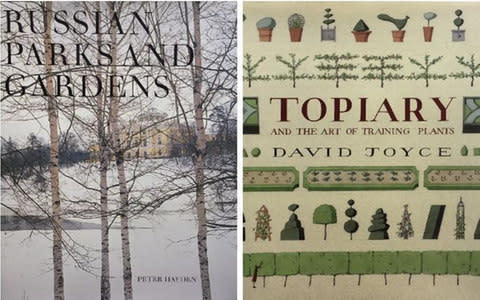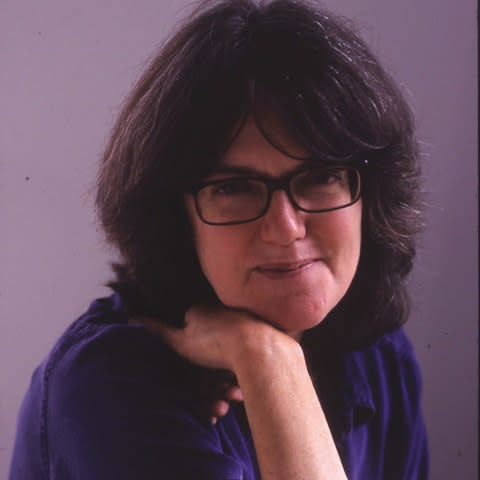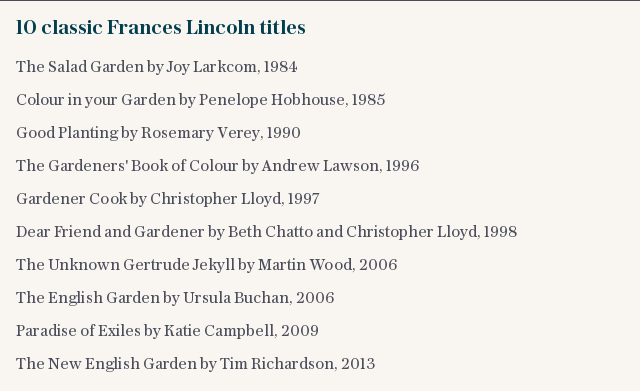Frances Lincoln closure marks end of an era for cultivated garden writing

The closure of publisher Frances Lincoln marks the end of an era in garden-book publishing. Its final title, Urban Rambles by Nicholas Rudd-Jones, will appear in July, after which the staff will produce books under the new imprint White Lion, launched by the Quarto group, which acquired Frances Lincoln in 2011.
According to Richard Green, group publishing director at Quarto, the intention is “to continue the legacy and to keep production values as high as ever. It felt like it was the time for change: we had a number of small imprints [including Aurum and Jacqui Small], all working in silos, and we were thinking about how to reorganise internally so we can produce better books and sell more of them.”

Frances Lincoln’s editorial director, Andrew Dunn, announced his departure at the news, but otherwise, according to Green, there has been just one (voluntary) redundancy. However, as existing staff have been at pains to point out privately, this is quite a legacy – and quite a brand – to extinguish.
Founded in 1977 by the 29-year-old Frances Lincoln, the new publishing house quickly found its niche in the world of gardening. As Penelope Hobhouse recalls: “Frances always had very good ideas. I remember that in the beginning Rosemary Verey and I were offered three titles and we had to agree which one we would write. I published masses of books with her – my favourite was Garden Style (1988), where she gave me a lot of freedom. It helped that at that time the American market was just clamouring for our books."

From the Eighties into the 2000s, all of the biggest names in garden writing published with Frances Lincoln. Hobhouse and Verey were its most successful authors, while Christopher Lloyd, Roy Strong and Beth Chatto were also on its list. Other “cult” authors who found a home at Frances Lincoln included Joy Larkcom (doyenne of salad leaves), Anthony Noel (Great Little Gardens, 1999) and Sarah Raven (The Cutting Garden, 1996).
Andrew Lawson is the photographer perhaps most associated with the publisher – his own Gardeners’ Book of Colour (1996) remains a classic. So why was this publishing house so special? “It used to be very personal,” he says. “One felt like a friend of Frances herself. The key thing was that Frances Lincoln books were very well designed for the period. They were willing to work on things until they got it right. I remember having fortnightly meetings with my editor for a whole year.”

Jo Christian worked at Frances Lincoln from 1987 until 2012. “It was a good time for Frances to start in terms of the market,” she says. “There was a sense that the Americans would buy almost anything from us. I remember thinking to myself, ‘Really? Do you really want 30,000 copies of a book about Gloucestershire gardens?’”
The books were doing well in Britain, as well, of course, the market nourished by an appetite for a garden equivalent to the “shabby-chic” but nevertheless decidedly smart interiors style, which had been promoted by the likes of Nancy Lancaster. With its neoclassical effects and hedonistic planting, Verey’s own garden in Gloucestershire seemed to epitomise the style, though Sissinghurst always remained the benchmark.
As for working with Verey, Christian reports: “I can’t say that’s a particularly happy memory. She would ring you at six in the morning and 11 at night.”

The famously irascible Christopher Lloyd was another author Christian worked with. “In his Gardener Cook there was one particular picture of a lettuce which he was adamant we should not include. In the end we did, but his caption read, ‘A photogenic but badly grown lettuce’.”
Frances Lincoln died in 2001 at the age of 55, at which point her husband, John Nicoll (also a publisher), took over the reins of the business. He recalls how Frances first got the garden-publishing bug by commissioning John Brookes's The Small Garden, which appeared in 1977 under the Studio Vista imprint.
That year she was contacted by George Weidenfeld of Weidenfeld & Nicolson, who wanted to employ her as a commissioning editor. When Frances said she did not want to move, he suggested setting up a new company in her name. "George put in £90 and Frances put in £10," Nicoll recalls, "so there was no risk to Frances." After three years Weidenfeld pulled out and she became sole owner.

Nicoll agrees that Frances Lincoln chose a propitious time to venture into garden publishing, given technological improvements – especially if one was willing to experiment with cheaper printing in the Far East (which well-established publishers initially avoided).
“Then the Americans seemed to acquire this taste for Gloucestershire ladies’ gardens,” he adds. “Frances Lincoln sold immense amounts into the Dutch and German markets as well, and also to places like Yugoslavia.”
Ultimately, though, Nicoll agrees that it was high production values combined with the personal touch that meant that authors were happy to work with the publisher. “She was a very caring and committed person. She took her obligations to authors, and to foreign publishers, very seriously.”
Penelope Hobhouse encapsulates the secret of Frances Lincoln’s success even more succinctly: “We stay with people who look after us.”


